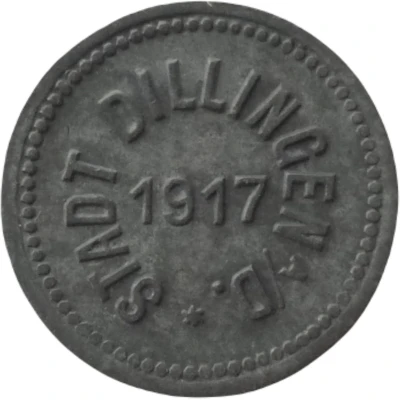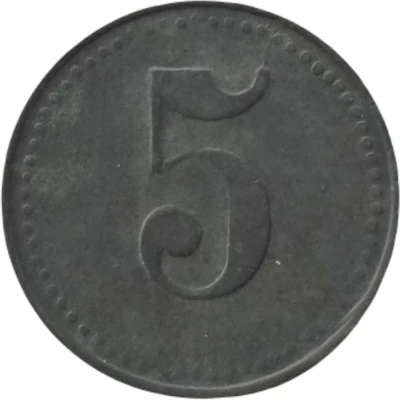


© Willem63 (CC BY-NC-SA)
5 Pfennigs - Dillingen
1917 year| Zinc | 1.4 g | 17.4 mm |
| Issuer | City of Dillingen an der Donau (Federal state of Bavaria) |
|---|---|
| Emperor | William II (Wilhelm II) (1888-1918) |
| Type | Standard circulation coin |
| Year | 1917 |
| Value | 5 Pfennigs (5 Pfennige) (0.05) |
| Currency | Mark (1914-1924) |
| Composition | Zinc |
| Weight | 1.4 g |
| Diameter | 17.4 mm |
| Thickness | 1.0 mm |
| Shape | Round |
| Technique | Milled |
| Orientation | Medal alignment ↑↑ |
| Demonetized | Yes |
| Updated | 2024-10-04 |
| Numista | N#36405 |
|---|---|
| Rarity index | 78% |
Reverse
Pearl rim surrounding denomination centered
Script: Latin
Lettering: 5
Edge
Plain
Comment
Issuing authority: [Stadt, Bayern]FUNCK (Edition 7 [2000]) ref.: 94.1a
Interesting fact
The 5 Pfennigs - Dillingen 1917 coin was minted during a time of economic turmoil in Germany, known as the "Inflationary Period" (1914-1923). During this time, the value of the German mark (the national currency) plummeted, and prices for everyday goods skyrocketed. As a result, many Germans turned to alternative forms of currency, such as local coins like the 5 Pfennigs - Dillingen 1917, which were issued by cities and towns across the country. Despite being made of zinc, a relatively inexpensive metal, these coins were highly valued by the local population due to their scarcity and the need for a stable medium of exchange. Today, the 5 Pfennigs - Dillingen 1917 coin is a rare and highly sought-after collector's item, serving as a reminder of a tumultuous period in German history.
Price
| Date | Mintage | VG | F | VF | XF | AU | UNC |
|---|---|---|---|---|---|---|---|
| 1917 | - | - | - | - | - | - |
Values in the table are based on evaluations by sales realized on Internet platforms. They serve as an indication only for 5 Pfennigs - Dillingen 1917 coin.